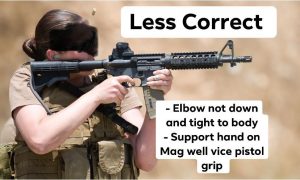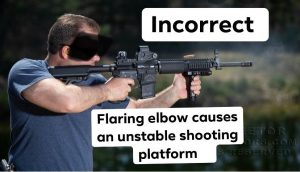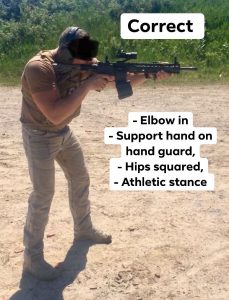
Shooting Skills – Carbine Shooting Fundamentals
Apr 17, 2023When I teach carbine shooting fundamentals or even pistol fundamentals for that matter, I start from the ground up, literally. However, the often repeated, “unless you intend to shoot, ALWAYS ensure your Finger is OFF the Trigger” is constantly inserted in the lesson.
Shooting Stance
Although this post will not focus on all 7 shooting fundamentals it will focus on some of the more critical points required for top tier shooting.
- Ensure your feet are approximately shoulder width apart, squared off to the target or threat (like a boxer). The support /strong side foot should be about 6” ahead of the non-dominant foot.
- Hips squared off to the target, in what we refer to as “the modified isosceles stance”
Maintain an athletic stance with a slight bend in the knees to help absorb the recoil from the carbine. The body should be canted forward at the hips slightly, also assuring in carbine recoil absorption. - Weight of the body transferred slightly to the balls of the foot
**Remember a perfect stance is a luxury and not absolutely necessary for shooting accuracy. Stability in stance helps with follow on shots**
Shooting Grip
- The shooters strong/dominant hand grasps the pistol grip of the carbine. The dominant hand STRONGLY PULLS the stock of the weapon into the body via the pistol grip. The support hand DOES NOT pull the carbine into the body, it supports the carbine by grasping the hand guard and driving the weapon from threat to threat.
- The support hand grasping the hand guard is relaxed enough to allow for quick presentation of the carbine from the low ready to threat ready or from one target then to other targets to the left or right.
- The strong hand thumb should constantly be touching/indexing the fire select/safety lever. This indexing allows for the shooter to quickly switch to fire from safe as quick as possible.
While the support hand grasps the hand guard, ensure the thumb is pointing forward toward the threat. Where the thumb points the muzzle follows.

PRO TIP Grasping the carbine mag well with the support hand is not wrong, however, it improperly allows for half of the carbine to be unsupported and this not stable. A less stable carbine results in longer time to set up the sights for follow on accurate shots. If you want to have quick accurate follow on shots I HIGHLY recommend grasping the hand guard of the carbine NOT the mag well…

PRO TIP – The strong arm should be in tucked into the body with the elbow down and tight to the body!! Physiologically, having the elbow tucked into the body provides the most stable shooting platform. When the elbow is up and out like a chicken wing (which is often done) the carbine is much more unstable and the front sights often move uncontrollably making sight alignment a challenge.

Pro Tip – Cardinal Rule of TACTICAL Carbine shooting: NEVER take your dominant hand off the pistol grip!**
Weapon Control
I don’t care if your providing direction, administratively loading the carbine, reloading, squeezing a team member to make entry, or conducting a tap rack, it really doesn’t matter the why…NEVER take your hand off the pistol grip of your carbine.
When you need to use your hand for a weapons drill or operational reason, take your support hand off the hand guard/rails and use your support hand only.
Train yourself to always keep that dominant hand on the pistol grip, the only exception is, a hard malfunction, pistol transition or putting the carbine away.
You want to train to keep the hand on the pistol grip to allow you to be immediately ready to pull the trigger at anytime. If the enemy surprises you, the last thing you want is to the take the few seconds needed to reacquire your grip.
Conclusion
The reality of tactical shooting is there are a number of skilled instructors around the world who can provide high quality instruction. There are even less who have deployed these tactics in an operational theatre such as a war zone or in law enforcement.
Instructors who have been deployed in local or international theatres have a very common trait. They are less rigid about a “one size fits all” solution, but rather focus on teaching you to think critically and introduce speed within the framework of basic shooting fundamentals.
John Black

